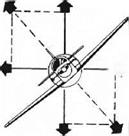Turn, Turn, Turn
Another thing a pilot learns early on is how to turn. Turning an airplane seems simple—you just bank the airplane while staying at the same altitude. But in truth, every turn requires a smooth coordination of the elevators, the ailerons, and the rudder.
To begin a turn, a pilot first looks for traffic, other airplanes, in the direction she is going to turn.
Once the pilot is sure there are no planes in the direction she’s going to turn, she makes a gentle bank to the right by moving the aileron controls. The movement of the control column is almost identical to the turning of a steering wheel in making a right turn in a car.
When the control column is turned toward the right, the aileron on the right wing deflects upward; at the same time the aileron on the left wing deflects downward. That’s because the ailerons are rigged to always move in opposite directions to each other.
The relative wind strikes the turned-up aileron on the right wing, pushing the wing slowly downward. By the same token, the rushing
over the left wing creates even more lift than usual because the down-turned aileron gives the wing an exaggerated curve. (You’ll recall that the curved upper surface of the wing is what gives it lift, and greater curve means greater lift.)
|
On Course It sometime! takes a keen eye to see the subtle movements of the ailerons, especially in a jetliner that’s flying very fast. That’s because the speed of the relative wind flowing across the wings is so fast that the ailerons only need to move a millimeter or so to take effect. The slower the airplane flies, the more noticeable the movement will be, because slower air is less effective. Larger deflections are needed to control the airplane’s bank angle. |
Now the rudders come into the picture. When the ailerons are being used, each wing experiences different amounts of drag. The wing that is swinging upward has more lift, but with extra lift comes extra drag.
While the left wing is rising and feeling more drag, the right wing is dropping. Because it’s losing lift, it is also feeling less drag. So even though the pilot wants to turn right, she’s noticing the drag of the left wing is pulling the nose slightly to the left.
The solution is a small foot pressure on the right rudder pedal. Even a small amount of rudder pressure will move the rudder surface enough to keep the nose turning right, counteracting the left-turning tendency created by the differences in aileron drag. Of course, the same principles apply to left turns, which require a slight pressure on the left rudder pedal.
The elevator controls must also be used during a turn—even if the pilot doesn’t want to climb or descend. Imagine the bank angle has been established at, say, 30 degrees. Because lift acts directly perpendicular to the wings, the lift force is acting at a 30- degree angle from straight up.
But weight always acts straight down. Let’s say the airplane weighs 2,500 pounds. No matter what the bank angle, the weight remains constant. But when the wings bank and the lift force is deflected, the lift is no longer opposite to the direction of weight. Now, with the lift pointed sideways, the weight exceeds lift. Unless the pilot does something, the plane will start a slow descent.
In order to restore the lost lift, the pilot pulls back gently on the control column, increasing the wings’ angle of attack and restoring lift.
And, finally, because the pilot is creating extra lift, she’s also creating more drag. That means she has to increase the throttle to provide the extra thrust to balance the increased drag.
Here we have one of the simplest of maneuvers, the basic turn. But it involves all the flight controls the pilot has at her disposal. The ailerons are deflected, the rudder is pressed, the elevators come into play, and the throttle balances the increase in drag.
With practice, the turn, like most of the maneuvers of flight, becomes second nature.
—Ф Centrifugal force
![]()
![]()
![]()
![]()
 Load
Load
Factor
A turning airplane creates centrifugal force that
makes the airplane behave as if it has gained weight.
(FAA Flight Training Handbook)
The Least You Need to Know
Lift combines simple "action-reaction’ force with the gentle but effective force of low-pressure air.
^ Drag takes a stem toll on an airplane, and engineers work hard to reduce it
► Thrust which opposes drag, is caused when an engine accelerates air using a propeller or a jet engine.
^ The airplane’s control surfaces are used together to create the basic maneuvers of flight
щтшттттшятяяятяшттттш












